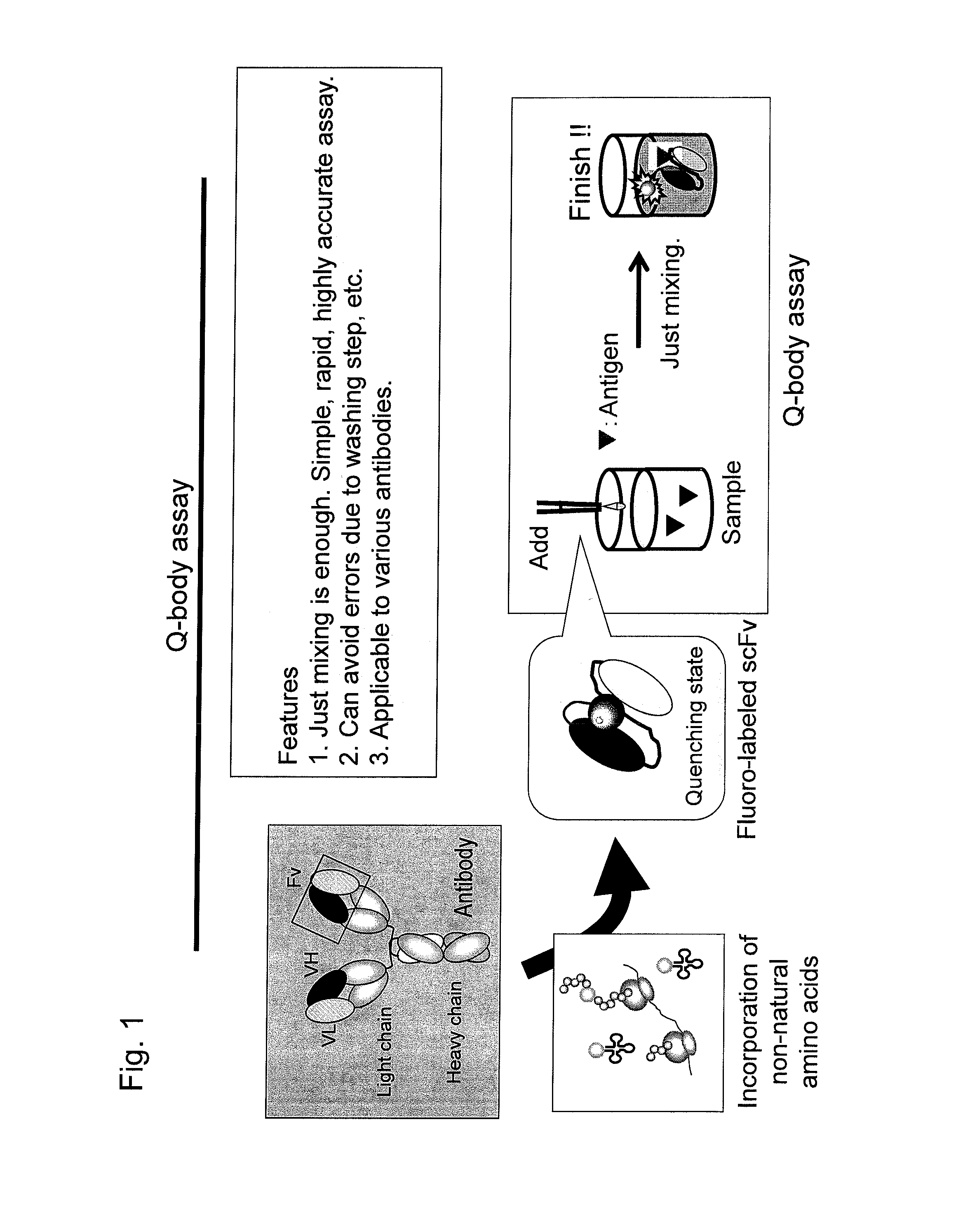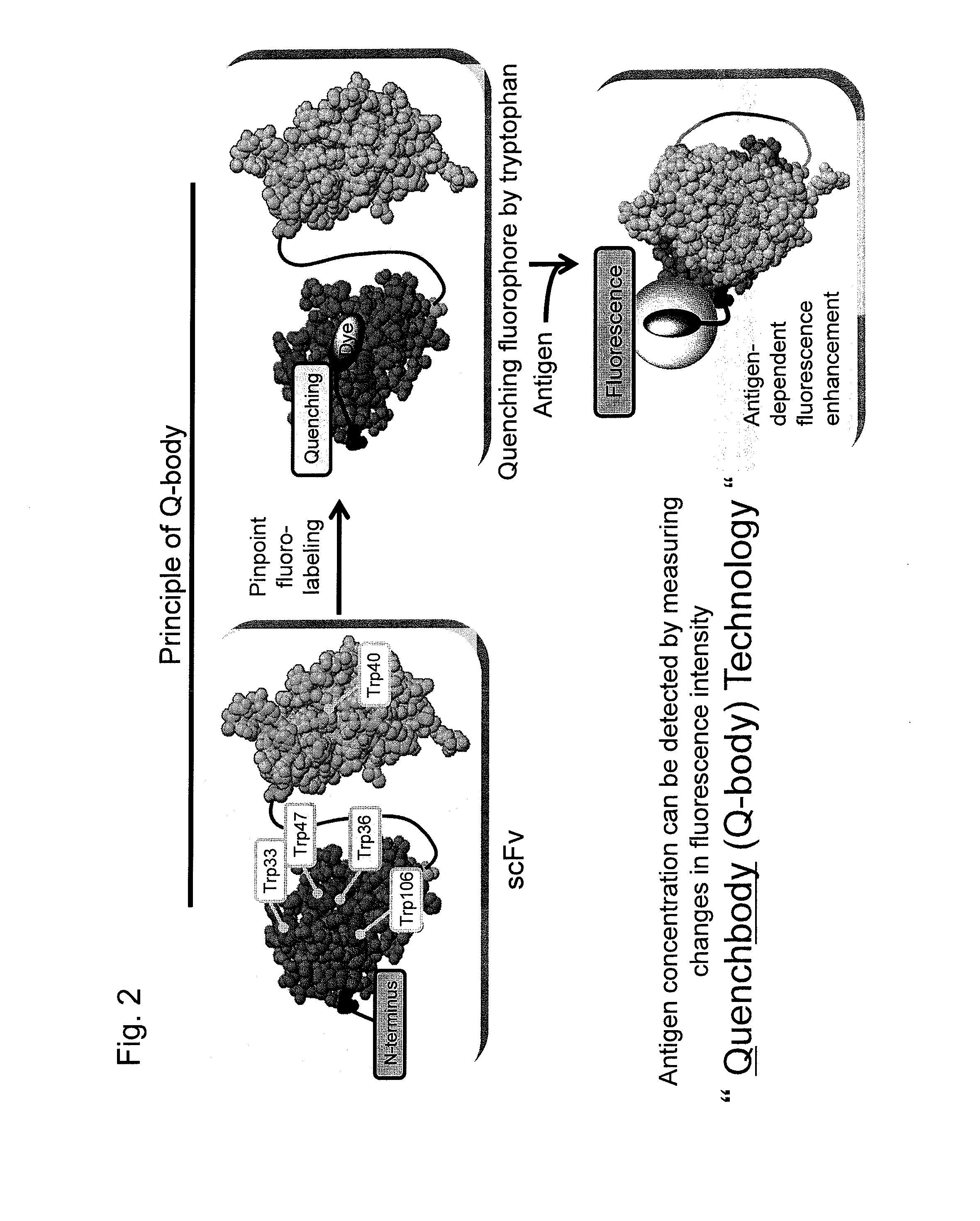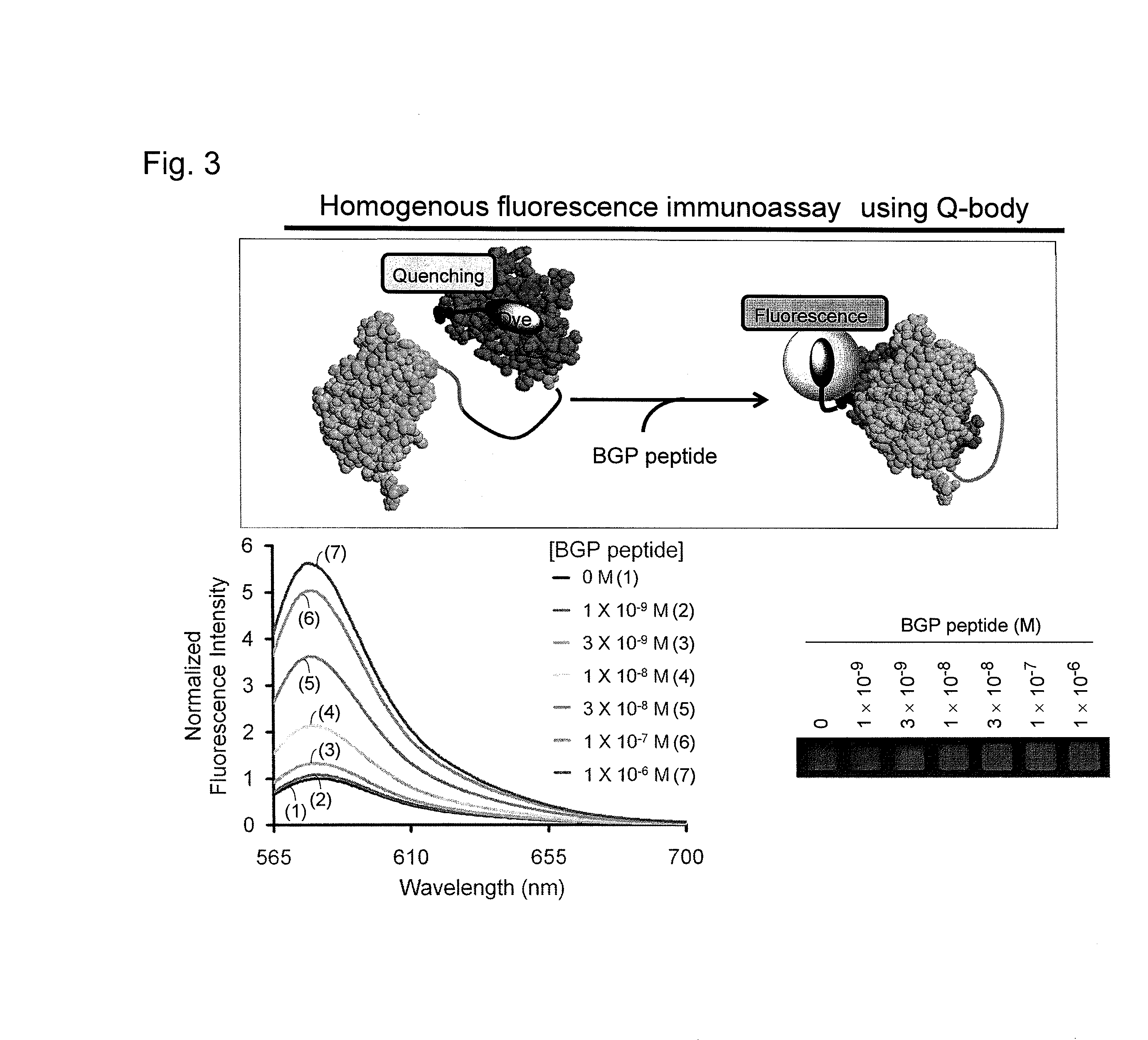Fluorescence immunoassay using polypeptide complex containing fluoro-labeled antibody variable region
a polypeptide complex and variable region technology, applied in the field of immunoassays using polypeptide complexes containing fluorolabeled antibody variable regions, can solve the problems of difficult preparation of plurality of antibodies that recognize different epitopes, low general versatility, and low fluorescence intensity, and achieve good sensitivity
- Summary
- Abstract
- Description
- Claims
- Application Information
AI Technical Summary
Benefits of technology
Problems solved by technology
Method used
Image
Examples
example 1
1. Establishment of Homogenous Fluorescence Immunoassay Using the Fluoro-Labeled Complex of the Present Invention
(Construction of Expression Vector)
1) Single-Label Fab Complex
[0073]A gene prepared by adding the DNA sequence of a ProX (trade name) tag (the nucleotide sequence corresponding to the 9th amino acid is TTT, and MSKQIEVNFSNET; SEQ ID NO: 1 after translation) to the N-terminus and the DNA sequences of a linker (SEQ ID NO: 14) and a FLAG tag to the C-terminus of a DNA sequence encoding a polypeptide containing an anti-human osteocalcin (human Bone Gla Protein; BGP) antibody light chain variable region (VL; SEQ ID NO: 5) and an antibody light chain constant domain (Cκ; SEQ ID NO: 4) was incorporated into a pIVEX2.3d vector (Roche Diagnostics). A gene prepared by adding the DNA sequence of a ProX tag (the nucleotide sequence corresponding to the 9th amino acid is TAG and MSKQIEVNXSNET (X denotes fluoro-labeled amino acid) after translation; SEQ ID NO: 2) containing an amber co...
example 2
2. Measurement by Homogenous Fluorescence Immunoassay Using the Fluoro-Labeled Complex of the Present Invention
(Fluorescence Emission Spectrum Measurement Using Single-Label Fab Complex)
[0086]The TAMRA single-label anti-BGP antibody Fab complex, the TAMRA-labeled anti-BGP antibody scFv, or the TAMRA-labeled anti-BGP antibody VH+anti-BGP antibody VL prepared in Example 1, comprising a polypeptide containing an anti-BGP (human osteocalcin) antibody light chain variable region (VL; SEQ ID NO: 5) and an antibody light chain constant domain (Cκ; SEQ ID NO: 4), and a polypeptide containing a TAMRA fluorescence-labeled anti-BGP antibody heavy chain variable region (VH; SEQ ID NO: 3) and an antibody heavy chain constant domain (CH1; SEQ ID NO: 6) was used to measure the concentration of BGP. The TAMRA single-label anti-BGP antibody Fab complex, or the TAMRA-labeled anti-BGP scFv (70 nM, 6.25 μL), or the TAMRA-labeled anti-BGP antibody VH+anti-BGP antibody VL (70 nM / mL, 6.25 μL) and antigeni...
example 3
Fluorescence Emission Spectrum Measurement Using Same-Color Double-Label Fab Complex
[0087]The same-color double-label Fab complex (70 nM, 6.25 μl) prepared in Example 1, comprising a polypeptide containing a light chain variable region (VL; SEQ ID NO: 5) of an anti-BGP antibody labeled with CR110, TAMRA, or ATTO 655 fluorescent dye and an antibody light chain constant domain (Cκ; SEQ ID NO: 4) and a polypeptide containing a heavy chain variable region (VH; SEQ ID NO: 3) of an anti-BGP antibody labeled with the same dye and an antibody heavy chain constant domain (CH1; SEQ ID NO: 6) and antigenic BGP-C7 (0 to 10,000 nM) were prepared to a total of 50 μL with PBS containing 1% BSA (+0.05% Tween20). As a control, a single-label Fab complex sample wherein either a polypeptide containing anti-BGP antibody VL (SEQ ID NO: 5) and Cκ (SEQ ID NO: 4) or a polypeptide containing anti-BGP antibody VH (SEQ ID NO: 3) and CH1 (SEQ ID NO: 6) had been fluoro-labeled was prepared. These solutions were...
PUM
| Property | Measurement | Unit |
|---|---|---|
| heat resistance | aaaaa | aaaaa |
| heat resistance | aaaaa | aaaaa |
| temperature | aaaaa | aaaaa |
Abstract
Description
Claims
Application Information
 Login to View More
Login to View More - R&D
- Intellectual Property
- Life Sciences
- Materials
- Tech Scout
- Unparalleled Data Quality
- Higher Quality Content
- 60% Fewer Hallucinations
Browse by: Latest US Patents, China's latest patents, Technical Efficacy Thesaurus, Application Domain, Technology Topic, Popular Technical Reports.
© 2025 PatSnap. All rights reserved.Legal|Privacy policy|Modern Slavery Act Transparency Statement|Sitemap|About US| Contact US: help@patsnap.com



